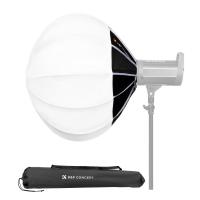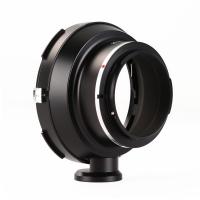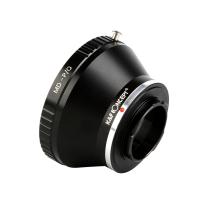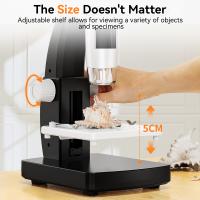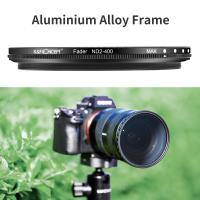How Does The Tem Microscope Work ?
A transmission electron microscope (TEM) works by passing a beam of electrons through a thin specimen to create an image. The electrons are emitted from an electron gun and accelerated by an electric field. They then pass through a series of electromagnetic lenses that focus and control the electron beam. The beam is directed towards the specimen, which is typically very thin and prepared on a grid.
As the electrons pass through the specimen, they interact with its atoms, scattering or transmitting through them. The transmitted electrons are collected by a detector, while the scattered electrons are blocked by an aperture. The intensity of the transmitted electrons is used to create an image of the specimen.
To enhance contrast and reveal fine details, the TEM uses various techniques such as staining the specimen with heavy metals or using phase contrast imaging. The resulting image is then magnified and displayed on a fluorescent screen or captured digitally.
Overall, the TEM allows for high-resolution imaging of the internal structure of specimens at the atomic level, making it a powerful tool in various scientific fields.
1、 Principles of TEM imaging and electron beam interaction.
The transmission electron microscope (TEM) is a powerful tool used to study the structure and composition of materials at the atomic scale. It operates on the principles of TEM imaging and electron beam interaction.
In a TEM, a beam of electrons is generated by an electron gun and accelerated towards the sample. The electrons pass through a series of electromagnetic lenses that focus and shape the beam. The sample is placed in the path of the electron beam, and as the electrons interact with the sample, they undergo various interactions that provide valuable information about the sample's structure and composition.
One of the key interactions is elastic scattering, where the electrons are deflected by the atomic nuclei in the sample. This scattering produces a diffraction pattern, which can be used to determine the crystal structure of the material. Another important interaction is inelastic scattering, where the electrons lose energy and are scattered by the sample's electrons. This interaction provides information about the sample's electronic structure and can be used to study chemical bonding and electronic properties.
To form an image, the transmitted electrons are collected by a detector and converted into a visible signal. This signal is then magnified and displayed on a screen or recorded digitally. By scanning the electron beam across the sample, a high-resolution image can be obtained.
Recent advancements in TEM technology have led to improved resolution and sensitivity. For example, aberration correction techniques have been developed to correct for imperfections in the electromagnetic lenses, resulting in higher resolution images. Additionally, the development of electron energy loss spectroscopy (EELS) and energy-filtered TEM (EFTEM) techniques has allowed for the analysis of elemental composition and chemical bonding at the nanoscale.
In summary, the TEM works by generating a beam of electrons, which interacts with the sample to provide information about its structure and composition. Recent advancements have further enhanced the capabilities of TEM, making it an indispensable tool for materials science and nanotechnology research.

2、 Electron source and electron optics in a TEM.
The transmission electron microscope (TEM) is a powerful tool used to study the structure and composition of materials at the atomic level. It works by using a beam of electrons instead of light to image the sample. The key components of a TEM are the electron source and electron optics.
The electron source in a TEM is typically a heated filament or a field emission gun. These sources produce a beam of electrons that is accelerated towards the sample. The electrons are negatively charged particles, and their high energy allows them to penetrate through the sample.
Once the electron beam is generated, it passes through a series of electromagnetic lenses known as electron optics. These lenses are responsible for focusing and controlling the electron beam. They consist of magnetic coils that generate magnetic fields, which can manipulate the path of the electrons.
The first lens in the electron optics system is the condenser lens, which focuses the electron beam onto the sample. The beam then interacts with the sample, and some of the electrons are scattered or absorbed, while others pass through.
After interacting with the sample, the transmitted electrons are collected by the objective lens. This lens further focuses the electrons and forms an image of the sample on a fluorescent screen or a digital detector. The image can then be observed and analyzed.
In recent years, advancements in TEM technology have led to the development of aberration-corrected electron optics. These systems use additional electromagnetic lenses to correct for aberrations, resulting in improved resolution and image quality. Furthermore, the use of electron detectors with high sensitivity and speed has allowed for faster data acquisition and improved imaging capabilities.
Overall, the electron source and electron optics in a TEM work together to generate a focused electron beam, interact with the sample, and form an image. These advancements in TEM technology continue to push the boundaries of our understanding of materials at the atomic scale.

3、 Sample preparation techniques for TEM analysis.
The transmission electron microscope (TEM) is a powerful tool used to study the structure and composition of materials at the atomic level. It works by passing a beam of electrons through a thin sample, which interacts with the sample and produces an image.
The first step in TEM analysis is sample preparation. This involves obtaining a thin sample, typically less than 100 nanometers thick, which allows the electrons to pass through. There are several techniques for sample preparation, including mechanical thinning, ion milling, and focused ion beam (FIB) milling. Mechanical thinning involves using a microtome to slice the sample into thin sections. Ion milling uses a beam of ions to gradually remove material from the sample surface. FIB milling uses a focused beam of ions to selectively remove material from the sample.
Once the sample is prepared, it is loaded into the TEM chamber. The TEM consists of several components, including an electron source, electromagnetic lenses, and a detector. The electron source emits a beam of electrons, which is focused and accelerated by the lenses. The beam then passes through the sample, where it interacts with the atoms and scatters. Some of the scattered electrons are collected by the detector, which converts them into an image.
The resulting TEM image provides detailed information about the sample's structure and composition. It can reveal features such as crystal lattice arrangements, defects, and interfaces. In recent years, advancements in TEM technology have allowed for higher resolution imaging and the ability to study materials in situ, under various environmental conditions.
In conclusion, the TEM microscope works by passing a beam of electrons through a thin sample and collecting the scattered electrons to produce an image. Sample preparation techniques, such as mechanical thinning and ion milling, are crucial for obtaining a suitable sample for TEM analysis. The latest advancements in TEM technology have further enhanced its capabilities, enabling researchers to study materials at the atomic level with unprecedented detail.

4、 Imaging modes and contrast mechanisms in TEM.
The transmission electron microscope (TEM) is a powerful tool used to study the structure and composition of materials at the atomic scale. It works by passing a beam of electrons through a thin sample, which interacts with the sample and produces an image.
The TEM operates in several imaging modes, each providing different types of information about the sample. The most common mode is bright-field imaging, where the transmitted electrons are collected and used to form an image. This mode provides information about the sample's thickness and density variations. Dark-field imaging, on the other hand, collects only the scattered electrons, resulting in an image that highlights defects, dislocations, and other structural features.
Contrast mechanisms in TEM are based on the interaction of electrons with the sample. The two main contrast mechanisms are phase contrast and Z-contrast. Phase contrast relies on the phase shift of the electron wave as it passes through different regions of the sample, resulting in variations in brightness and contrast. Z-contrast, also known as high-angle annular dark-field (HAADF) imaging, utilizes the variation in atomic number and scattering cross-section to produce contrast. This technique is particularly useful for studying materials with heavy elements.
In recent years, advancements in TEM technology have allowed for even higher resolution imaging. Techniques such as aberration correction and electron energy loss spectroscopy (EELS) have improved the spatial and spectral resolution, enabling the study of individual atoms and their chemical bonding. Additionally, in-situ TEM techniques have been developed, allowing for the observation of dynamic processes in real-time.
Overall, the TEM is a versatile tool that provides detailed information about the structure and composition of materials at the atomic scale. Ongoing advancements continue to push the boundaries of resolution and enable new insights into the properties and behavior of materials.
























